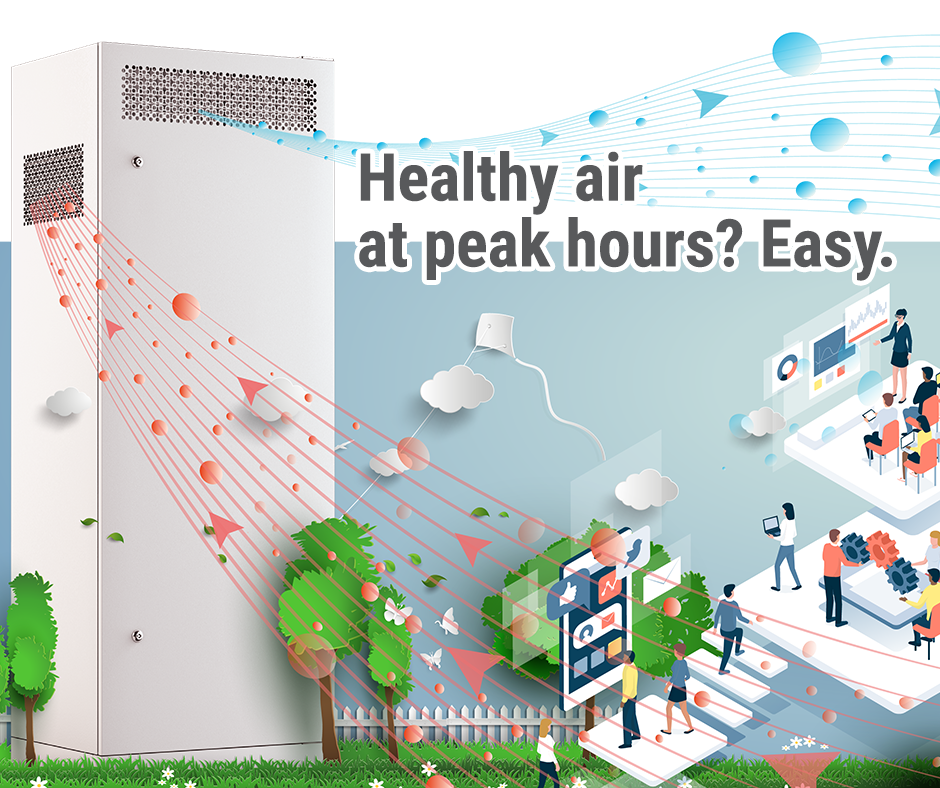Healthy air at peak hours? Easy.

Healthy air at peak hours? Easy.
We are currently confronted with a new task, namely to find out what is dangerous and what is not, and how we should behave based on the current data on coronavirus and the danger of its spread. Some only look for the answers for themselves, others have to take responsibility for an entire workforce or school.
Buzzwords like “aerosol” (any mixture of suspended particles in gas), which one rarely heard before, are becoming important. When you start researching, you come across a wide variety of rapidly changing and often contradicting information and opinions, which makes you more confused than before.
HOWEVER, AT SOME POINT YOU START DISTINGUISHING WHAT INFORMATION IS CONSISTENTLY VALID AND REALLY BRINGS POSITIVE RESULTS IF UTILIZED
We focus here on the topic of air quality. How can I reduce the risk of infection and disease, and how can I increase health by improving the indoor air quality?
There are plenty of studies on this, starting in the middle of the 19th century with Max von Pettenkofer’s findings on the connection between the CO2 content of indoor air and the well-being of people. However, two major factors arise from the large set of studies:
The pure probability calculation: the more people and activities there are in a room, the more particles there are inside from breathing, evaporation, and turbulence. Including pathogens, of course, which accumulate if there is insufficient fresh air supply. In addition, there are particularly polluted areas that the air flow does not reach or in which there are more people than in other areas. In short: the thicker the air/aerosol, the higher the risk of infection.
Physical condition based on air quality: depending on air content, one feels better or worse, this can be subjectively evaluated. The content of CO2 is of decisive importance here, therefore, increased concentrations of CO2 result in dizziness, headaches and concentration disorders, up to irritation of the respiratory tract, diseases, etc. Humidity is also an important factor: too low humidity causes mucous membranes to dry out, causing discomfort and making the respiratory tract more vulnerable. Air that is too humid impairs the body’s temperature regulation and provides a welcome environment for some pathogens and mould spores. If the air quality is unsatisfactory, the body is very busy maintaining normal functions at the expense of the immune system and is thus a better target for infectious pathogens.
The impact of air quality on health is so clear that some employers’ liability insurance associations have already committed to monitoring this topic at schools and companies.
The solution to this problem, of course, is proper ventilation. One approach is traditional window ventilation, which, among other things, is recommended in the form of shock ventilation at regular intervals and cross ventilation through opposite windows. The feel-good effect of fresh air is immediate. Far more difficult is to ensure a sufficient air exchange rate, supply air to all corners and maintain a balance of humidity and temperature (and, therefore, heating costs).
In order to manage these factors in addition to the fresh air supply, controlled ventilation was developed using so-called air conditioning systems (HVAC systems). Here, ventilation systems built into the walls ensure regular air exchange. Stale extract air and particles contained in it are removed from the room, and fresh intake air is supplied, often cleared of unwanted substances through filters. Air exchange with fresh outdoor air is important here, since the O2/CO2 content as a decisive factor cannot be improved by simply circulating and filtering the indoor air. The rule is: only fresh air brings healthy air. A well thought-out arrangement of ventilation elements ensures air exchange throughout the room. Models with moisture and heat recovery are particularly energy-efficient and ensure that a healthy and pleasant room climate is maintained, including the right humidity. For more details follow the link: https://blaubergventilatoren.de/uploads/download/aerosoleflyera56seitenengl.pdf
The disadvantage of this ventilation method is that it actually has to be taken into account when planning the building. Unless you use ventilation systems that can be subsequently installed, such as those made by Blauberg Ventilatoren from Munich. These can be inserted through a core hole in the existing wall and put into operation immediately after being connected to the power supply. Since they can be used individually in the various rooms without central pipework, they are called single-room ventilation systems. Installation and operation of such systems are designed to be simple and user-friendly. Thanks to a wide range of setting options, for example, different air flow rate can be selected at different times of the day, and the ventilation of the premises can be adapted to individual needs. With the help of these ventilation systems, adequate and health-promoting ventilation can be guaranteed and controlled in accordance with current guidelines, thus protecting your own health and that of your employees and roommates.
In Touch
contact you shortly.

